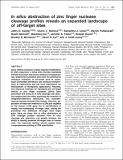In silico abstraction of zinc finger nuclease cleavage profiles reveals an expanded landscape of off-target sites

View/
Author
Shoresh, Noam
Ku, Manching
Foden, Jennifer A.
Joung, J. Keith
Note: Order does not necessarily reflect citation order of authors.
Published Version
https://doi.org/10.1093/nar/gkt716Metadata
Show full item recordCitation
Sander, J. D., C. L. Ramirez, S. J. Linder, V. Pattanayak, N. Shoresh, M. Ku, J. A. Foden, et al. 2013. “In silico abstraction of zinc finger nuclease cleavage profiles reveals an expanded landscape of off-target sites.” Nucleic Acids Research 41 (19): e181. doi:10.1093/nar/gkt716. http://dx.doi.org/10.1093/nar/gkt716.Abstract
Gene-editing nucleases enable targeted modification of DNA sequences in living cells, thereby facilitating efficient knockout and precise editing of endogenous loci. Engineered nucleases also have the potential to introduce mutations at off-target sites of action. Such unintended alterations can confound interpretation of experiments and can have implications for development of therapeutic applications. Recently, two improved methods for identifying the off-target effects of zinc finger nucleases (ZFNs) were described–one using an in vitro cleavage site selection method and the other exploiting the insertion of integration-defective lentiviruses into nuclease-induced double-stranded DNA breaks. However, application of these two methods to a ZFN pair targeted to the human CCR5 gene led to identification of largely non-overlapping off-target sites, raising the possibility that additional off-target sites might exist. Here, we show that in silico abstraction of ZFN cleavage profiles obtained from in vitro cleavage site selections can greatly enhance the ability to identify potential off-target sites in human cells. Our improved method should enable more comprehensive profiling of ZFN specificities.Other Sources
http://www.ncbi.nlm.nih.gov/pmc/articles/PMC3799455/pdf/Terms of Use
This article is made available under the terms and conditions applicable to Other Posted Material, as set forth at http://nrs.harvard.edu/urn-3:HUL.InstRepos:dash.current.terms-of-use#LAACitable link to this page
http://nrs.harvard.edu/urn-3:HUL.InstRepos:11878851
Collections
- FAS Scholarly Articles [18292]
- HMS Scholarly Articles [17922]
- SPH Scholarly Articles [6362]
Contact administrator regarding this item (to report mistakes or request changes)


